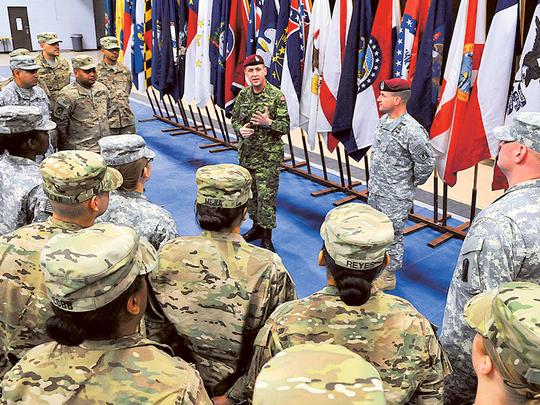
Washington: President Barack Obama’s view of the US role in the Middle East and North Africa is being challenged by deepening crises in the very countries he has seen as models for his approach to the volatile region: Iraq, Syria, Yemen and Libya.
After making good on his pledge to end large-scale American ground wars in the region, Obama has inched the US military back into Iraq. The targeted counterterrorism campaigns Obama prefers to ground combat have weakened some extremists, but done little to quell the chaos in which terror groups thrive, or ward off the formation of new factions, like Daesh. And Obama’s calls for regional governments and local security forces to take the lead for stabilizing their own countries has often only exposed the weaknesses of those institutions.
The White House acknowledges that the terror threat has spread throughout the region, though officials argue the risk to the US posed by groups like Daesh is less than when Al Qaida was at peak strength. Still, US defense and intelligence agencies are deeply concerned about the number of countries buckling under a toxic mix of political chaos and security concerns.
A look at the situation in countries where Obama has tried to stake out a new model of American engagement in the Arab world:
IRAQ
It once looked as though Obama’s legacy in the Middle East would be bringing to an end the unpopular and expensive Iraq war. As he heralded the withdrawal of US troops in late 2011, Obama said the US was leaving behind a “sovereign, stable and self-reliant Iraq.”
But last year, a few thousand American troops returned to Iraq to help combat Daesh. And in August, the US began launching air strikes against militant targets in the country.
Obama’s critics have accused the president of putting his political interest in withdrawing from Iraq ahead of concerns about the security situation he was leaving behind. They argue the US pullout created a vacuum that allowed the Islamic State to thrive and capture large swaths of northern and western Iraq.
Obama pinned the blame for Daesh’s rise in part on the Iraqi government’s alienation of minority sects. US officials helped ease Prime Minister Nouri Al Maliki from office last year, but the political situation remains fragile.
Baghdad is still witnessing near-daily attacks by militants, including suicide and car bombings, seeking to undermine the government’s efforts to maintain security.
SYRIA
Syria has perhaps been the most vexing Middle East crisis confronting the White House.
Eager to keep the US out of the quagmire of Syria’s civil war, Obama threw his support behind diplomatic negotiations to oust Syrian President Bashar Al Assad from office, negotiations that repeatedly failed. He nearly launched air strikes against Al Assad after a 2013 chemical weapons attack, but backed away in favor of a negotiated settlement to strip Syria of its stockpiles of deadly gases.
“We now have the opportunity to achieve our objectives through diplomacy,” Obama said at the time.
But after nearly four years of fighting, the civil war rages on, more than 200,000 people have died and Al Assad remains in power. Obama reversed his opposition to training and equipping Syrian opposition forces, but that mission has been slow to develop.
It was ultimately Daesh that pushed Obama into military action in Syria. The US, along with Arab partners, started launching air strikes in September, but the White House continues to lack a clear plan for getting Assad to leave power and ending the civil war.
YEMEN
When Obama announced air strikes against Daesh in Iraq and Syria, he held up Yemen as a successful story for how the US could fight terrorism without being drawn into ground combat.
For years, the White House had heralded its counterterrorism partnership with Yemen’s government and its drone-based attacks on the country’s dangerous Al Qaida branch. Yemen’s military has also received heavy aid from the US in hopes it could be built into an effective bulwark against Al Qaida in the Gulf.
But Al Houthi rebels overran Yemeni forces and seized power. Within days, the US closed its embassy, complicating the US counterterrorism campaign.
LIBYA
While Obama spent his first term trying to end US military action in the Arab world, Libya became an example of where Obama was willing to engage.
The US joined NATO partners in a 2011 bombing campaign to support a popular uprising against longtime dictator Muammar Gaddafi, who was toppled and killed. Obama said at the time that it would have been a “betrayal” of US values to not assist the Libyans.
But the US and Western partners largely left the post-Gadhafi transition to Libya. Widespread militia violence has plunged the country into chaos and two rival governments and parliaments rule the country’s eastern and western regions.
Among the groups taking hold there has been Daesh. On Sunday, the militants released a video purporting to show the beheading of 21 Egyptian Christians, mainly young men from impoverished families who were kidnapped after travelling to Libya for work.












